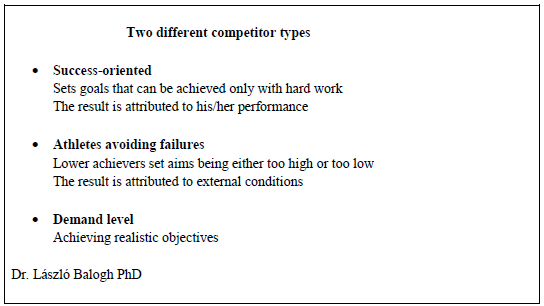What do we want to achieve? – Aims and goals
We cannot be motivated until we have set our aims. Considering this fact the work focusing on achieving aims and goals are indispensable. This is the primary factor of mental preparation. If athletes are not aware of their aims then there is no reason for competing. Unfortunately in our practice we have already experienced that there are athletes who have no clear aims while doing sports for years.
Needless to say that the aims should be clear, achievable and meaningful. Successful athletes set goals that can be achieved only with hard work. When they have achieved this, their demand level rises. If they fail to achieve these goals they have a go again. In contrast lower achievers set aims which are either too high or too low. If they are either successful or fail to achieve their goals their self-image will not change parallel with this and their demand level will remain unchanged.

Figure 5. Two different competitor types and the relationship between achieving aims and demand level
It is worth mentioning Nicholl’s (1984 in Cashmore, 2008) achievement behaviour theory, see diagram 5. He defines achievement behaviour as the relationship between setting goals and demonstrating high capacity. Aims can indicate competences enabling athletes to acquire new techniques, gaining mastery to perform the right motions and defeating the others and winning. Successful athletes endeavour to gain in mastery and to focus on the tasks as each well chosen technique brings them closer to the final victory. In other words, the route towards success is important. The desire to win all cost is not a drawback but the performance of a task and the contest/race may loose importance. If the athletes who demonstrate high capacity use effort then others may do the same and this phenomenon is considered maximum performance (see Cashmore, 2008).

Figure 6. Performance as a goal